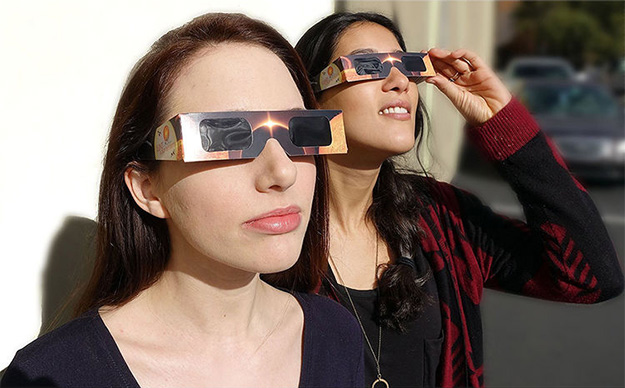Looking For Solar Eclipse Glasses? What To Avoid And Where To Find Safe Shades
Mark your calendars, folks—on Monday, August 21, 2017, all of North America will bear witness to a solar eclipse. What makes this one unique is that it will be the first total eclipse to go from coast to coast in the US in nearly a century, and the first to pass through the lower 48 states since 1979. As a result, there has been a big demand for solar glasses with special-purpose solar filters that allow you to safely look directly at the sun without wrecking your vision. If you are planning to watch the eclipse as it unfolds, you would be best suited to pick up a pair, though there are some things you should know before you go shopping.
Due to the immense demand, third-party vendors on places like Amazon are coming out of the woodwork with solar glasses that promise to protect your vision. Unfortunately, some of these sellers are...shady (see what we did there?). Glasses that are deemed safe for viewing directly at the sun must be verified compliant with the International Organization for Standardization's ISO 12312-2 safety standard. It is important to look for that logo, though be warned that unscrupulous sellers have been plastering the label on fake glasses that don't actually meet the standard.

"It now appears that some companies are printing the ISO logo and certification label on fake eclipse glasses and handheld solar viewers made with materials that do not block enough of the sun’s ultraviolet, visible, and infrared radiation to make them truly safe," the organization warned. "Some sellers are even displaying fake test results on their websites to support their bogus claim of compliance with the ISO safety standard."
That is a big problem because if you look directly at the sun without proper protection for your eyes, you could potentially do irreparable harm that adversely affects your vision. Like phone chargers and batteries, this is not something you want to chance with a cheap knockoff.
So, how can you tell which solar glasses are the real deal? The best thing you do is limit your search to reputable vendors from the American Astronomical Society (AAS), as NASA recommends. These vendors/brands include:
- American Paper Optics (Eclipser)
- APM Telecsopes (Sunfilter Glasses)
- Baader Planetarium (AstroSolar Silver/Gold Film)* [see note below]
- Celstron (EclipsSmart Glasses & Viewers)
- DayStar (Solar Glasses)
- Explore Scientific (Solar Eclipse Sun Catcher Glasses)
- Lunt Solar Systems (SUNsafe SUNglasses)
- Meade Instruments (EclipseView Glasses & Viewers)
- Rainbow Symphony (Eclpse Shades)
- Seymour Solar (Helios Glasses)
- Thousand Oaks Optical (Silver-Black Polymer & SolarLite)
- TSE 17 (Solar filter Foil)

These can be hard to find because of the overwhelming demand, and you may have to purchase them in packs. For example, American Paper Optics is completely out of stock on its website. However, you can check your local Walmart or Lowe's location, as both retailers carry the Eclipser glasses in-store.
If you're wiling to purchase more than one set of solar glasses, we found Lunt Solar Systems' SUNsafe SUNglasses in-stock at B&H Photo. A 5-pack goes for $12.95, plus shipping and handling. I live in Tennessee and ordered a set, which came to around $23 shipped. That's around twice as much as they should cost if I was able to find them locally, but it is better to go that route than take a chance with an unknown brand for cheap on eBay.
The path of the upcoming total eclipse where the moon fully covers the sun is a relatively thin ribbon measuring 70 miles wide. It crosses the US from the upper section of the West and runs down towards the mid section of the East. The first point of contact will be at Lincoln Beach, Oregon at 9:05 AM Pacific, with a total blackout occurring there at 10:16 AM Pactific.
It will then cross Oregon, Idaho, Wyoming, Montana, Nebraska, Iowa, Kansas, Missouri, Illinois, Kentucky, Tennessee, Georgia, and North and South Carolina over the next hour and a half. The total eclipse will end near Charleston, South Carolina at 2:48 PM Easter, and then leave the US at 4:09 PM Eastern. The longest duration will be near Carbondale, Illinois, where the moon will completely cover the sun for two minutes and 40 seconds.
Refer to the above chart for more specific times, depending on where you live. There is also an interactive map on NASA's website where you can click on your exact location and get the times for when the eclipse begins, is at its totality, and ends.
Happy viewing!



